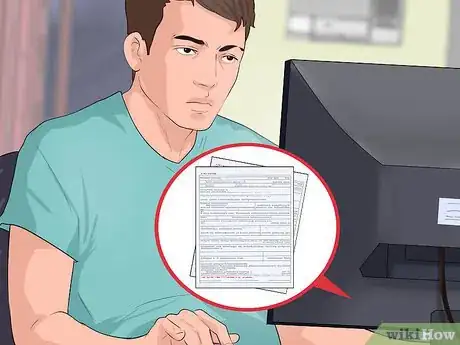This article was written by Jennifer Mueller, JD. Jennifer Mueller is an in-house legal expert at wikiHow. Jennifer reviews, fact-checks, and evaluates wikiHow's legal content to ensure thoroughness and accuracy. She received her JD from Indiana University Maurer School of Law in 2006.
This article has been viewed 21,906 times.
Intervention in legal cases is most common in child custody litigation. If you want to intervene in a legal case – whether with the plaintiff, with the defendant, or on your own with independent claims against either party – you must first file a motion and ask the judge's permission. Judges have broad discretion over whether to allow additional parties to join the case, particularly if the litigation process is far advanced. Due to the complexities of third-party litigation, you typically want to hire an attorney to represent you.
Steps
Drafting Your Motion
-
1Get copies of the pleadings. Before you can correctly format or draft your motion, you must have an understanding of the parties in the existing case so you can evaluate how your claims relate and how you would fit into the litigation.[1]
- Since all court cases are a matter of public record, you can get copies of the pleadings by visiting the clerk of the court in which the lawsuit was filed.
- Keep in mind that while you may be able to look at the documents in the clerk's office, you typically must pay a fee to have the clerk make a copy of those documents for you.
- The pleadings are a source of valuable information concerning the identity of the parties and the addresses at which they can be served. You'll need this so you can have your motion delivered to them.
- Your motion typically must provide a background of the case and your claim, as well as explaining why you are intervening and how your claims are relevant. You can't make these arguments without an understanding of the existing case.
- Generally, you may assert an intervention "as of right" or request a permissive intervention. If you claim intervention as of right, you must show that you have a direct interest in the dispute from which the case arises, and the only way to protect your interest is to become involved in the lawsuit.
- If you can't meet these requirements, you're claiming permissive intervention, which may include a common legal question raised in your claim and in the existing litigation, or a state law that allows you to intervene in the lawsuit if specific conditions are met.
-
2Search for templates or samples. Depending on the reasons you want to intervene, the court may have a form or template you can fill out if you want to file a motion to intervene on your own without hiring an attorney.
- For example, most courts have forms you can fill out if you are a grandparent or other relative who wants to intervene in a child custody or child welfare proceeding.
- In other civil cases such as breach of contract cases, there may not be a form that fits your situation. However, you may be able to look at motions filed in other cases to get an idea of how to draft your own.
- You can always ask the clerk of court what resources are available. Although the clerk can't offer legal advice on your particular situation, they can point you to forms or suggest samples for you to review, and tell you about various court procedural rules related to intervention.
- If you have serious questions or if the reasons you want to intervene are fairly complex, you probably should consider hiring an attorney to represent your interests. Keep in mind that if you make a mistake and your motion to intervene is denied, you may not have another opportunity to enter the litigation.
Advertisement -
3Format your motion. Since your motion relates to a case already being litigated, it carries the same caption as the original case, including the names of the party and the original case number. This information typically will not change even if your motion is granted.[2]
- If you're using a court-approved form, there typically will be blanks at the top of the first page for you to enter the title of the case (the plaintiff and the defendant) and the case number is was assigned.
- If you're drafting your motion from scratch, format your caption in the same way you see it formatted in the other pleadings.
- Title your motion below the caption. Your title can be as simple as "Motion to Intervene." If you want to join the case on a particular side, you can add that information to the title as well. Generally, keep your title brief and descriptive of your motion.
- The body of a motion typically is written in paragraph form, with an introductory paragraph identifying who you are and what you're asking of the court.
- Depending on the complexity of your reasons for intervening, you may include a discussion of those in the body of your motion, or create a separate memorandum with your factual reasons and legal arguments.
-
4Create a memorandum of support. In some courts, a memorandum is not required if you are not represented by counsel. If you have hired an attorney, they typically will draft a memorandum of support that sets forth the reasons you want to intervene in the case.[3]
- Because memoranda typically include extensive and detailed legal arguments, including citations to rules and higher court opinions, courts typically neither require or expect them from litigants who are representing themselves.
- You can look at samples of these memoranda filed in other cases if you want to get an idea of the kinds of information they include, even if you don't plan to file one to accompany your motion.
- A well-crafted memorandum of support forms the basis of the argument you will make in front of the judge at the hearing, and outlines the reasons the law supports your ability to intervene in the case.
- Generally, your claims and the issues you raise must be fairly closely related to the claims asserted in the original case, and the court must have jurisdiction over them.
- For example, if you're attempting to intervene in a family court case regarding child custody, that court may not have jurisdiction over a breach of contract claim you have against one of the parties.
Filing Your Motion
-
1Sign your documents. Once you've completed all of the documents required by the court, you must sign the originals and then make copies of the signed documents. Generally, you should have one copy for each existing party and at least one copy for your own records.
- Contact the clerk before you sign, especially if you're representing yourself. Some courts require litigants to sign their documents at the clerk's office before the clerk, or to sign them in the presence of a notary public.
- You also can find out from the clerk what other forms you need to have completed to file with your motion. These documents vary depending on the court in which you're filing your motion, but may include a certificate of service or a notice of hearing.
- Additional documents typically follow the same format regardless of the case or the specifics of your motion, and you can find forms either at the clerk's office or on the court's website.
-
2Take your documents to the clerk. To have the judge decide on your motion you must file it with the clerk for the court where the case is being litigated. The clerk will file-stamp your originals and copies, and keep the originals for the court's files.
- Keep one file-stamped copy for your own records. Make sure you have at least one copy for each of the parties in the existing case. They must be served with your motion so they have notice that you are asking to intervene so they have fair opportunity to oppose your motion.
- Expect to pay a filing fee when you give your motion to the clerk. This fee varies greatly among courts, but typically is around $100.
- If you cannot afford filing fees, you can ask the clerk for an application for a waiver. You must provide information about your income and assets, and if they fall below the court's threshold you won't have to pay fees.
-
3Have the other parties served. All other parties in the case must have notice of your motion so they have the opportunity to respond and present their arguments to the judge, whether for or against your intervention.
- You typically have the choice of personal service or mail service. Mail service usually will be the cheapest and most convenient option for you.
- With mail service, you send the documents to each of the parties using certified mail with returned receipt requested. The party must sign when they receive the documents.
- You will get a green card in the mail after the documents are successfully delivered, and this card serves as your proof of service.
- You also may opt for personal service, in which you hire a sheriff's deputy or a private process server to hand-deliver the documents to the parties.
-
4Complete your notice and service forms. Once the other parties have been successfully served, you typically are responsible for completing a certificate or affidavit of service and filing it with the clerk.
- If you chose personal service, typically the individual who completes the service fills out the affidavit of service, although you may be responsible for filing it with the court.
- With mail service, you must file the affidavit or proof of service yourself. Attach the green card, or a photocopy of it, to your proof of service form.
Attending Your Hearing
-
1Receive any responses. All parties have the option of filing a written response – either in support or in opposition – to your motion. You will be served with a copy of these responses, and may have the option of filing an additional reply.[4]
- Regardless of whether you plan a written response, make sure you understand the arguments made by the other parties in their response memoranda. These are the arguments they will make at the hearing, and you need to understand how to react to them.
- If one of the parties has filed a written response in support of your motion, they have in a sense done your homework for you. Although their response provides reasons your intervention is in their best interests, you can use these reasons to enhance and solidify your own arguments.
- If one or both of the existing parties in the case have filed responses in opposition to your motion, you must carefully dissect these arguments so you understand how to overcome them.
- Assuming you do not have an attorney at this point, you may be able to pay someone a flat fee to go over the documents and explain the arguments for you, give you advice on your ability to intervene in the case, or even assist you at the hearing on your motion.
- Especially this late in the game, if you decide you want an attorney you should act as quickly as possible. The date for your hearing has likely already been set, and you may have difficulty finding someone who is available at that time on short notice.
-
2Appear in court on your scheduled date. The judge to whom the original case was assigned likely will hear the motion on a regular "motion day," during which motions in many different cases are heard one after the other.
- If you're going to court by yourself, make a detailed outline of the reasons you are intervening in the case. Provide two or three facts or points that support each of your reasons.
- Take your outline to court with you along with all of your documents, including your motion, any responses, and the pleadings from the original case.
- Take a seat in the gallery of the courtroom and wait until your motion is called. Expect to spend most of the day in court, as your motion may not be the first one called.
- If you're not familiar with the setting, call the clerk's office or visit the court's website before the date of your hearing to find out what items are specifically prohibited in the courtroom and read the court's general rules on how to behave.
-
3Present your arguments. When your motion is called, you will have the opportunity to explain to the judge why you believe you should be added as a party to the case. Be ready to explain whether you believe you have the right to intervene, and why the court has subject matter jurisdiction over your claim.[5]
- Speak slowly in a loud, clear voice so the judge can hear and understand you. If the judge asks you a question, stop speaking and respond to the judge before you continue your statements.
- When you're presenting your argument, you should address your statements to the judge alone – don't talk to either party or engage in any conversations with them.
- Follow the outline you prepared of your reasons. Stick to the facts of the case, your claim, and why you want to intervene.
- Once you've finished your statements, the other parties typically will be given a chance to explain to the judge why they either support or oppose your intervention.
- If one or both parties opposes your intervention, the judge may give you an opportunity to respond further to any additional points or reasons they raised.
-
4Receive the judge's decision. After all sides have been heard, the judge will make his or her decision as to whether you should be allowed to intervene in the case. The judge has broad discretion to deny your motion, even if you asserted intervention as of right.
- The judge may let his or her decision be known right then, or take the matter under advisement and issue a written order later.
- If the judge indicates he or she will take the matter under advisement, you may want to ask the clerk when you can expect a decision and whether you'll be notified when the order is issued.
- If the judge denies your motion, you may want to talk to the existing parties in the case about other potential methods that can be used to bring you into the action – especially if one or both of the parties supported your intervention.
References
- ↑ https://www.justice.gov/file/miami-u-motion-intervene/download
- ↑ https://www.justice.gov/file/miami-u-motion-intervene/download
- ↑ https://www.justice.gov/file/miami-u-motion-intervene/download
- ↑ https://www.judiciary.state.nj.us/prose/10556_response_to_a_motion_kit.pdf
- ↑ https://www.judiciary.state.nj.us/prose/10556_response_to_a_motion_kit.pdf







































































